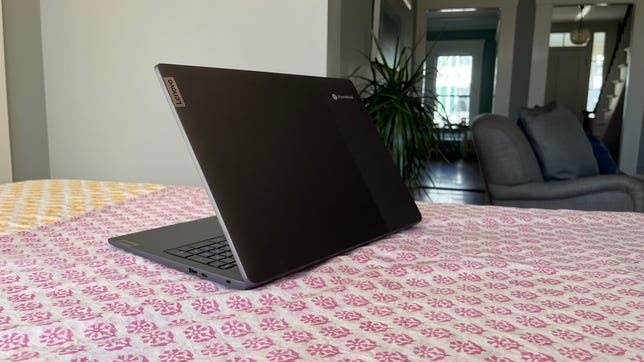Technologies
Lenovo IdeaPad 5i Chromebook: A Roomy Display Backed by Processing Power
A rare 16-inch, 16:10 display with an Intel Core i3 CPU makes this Lenovo Chromebook a good fit for work and play at home.
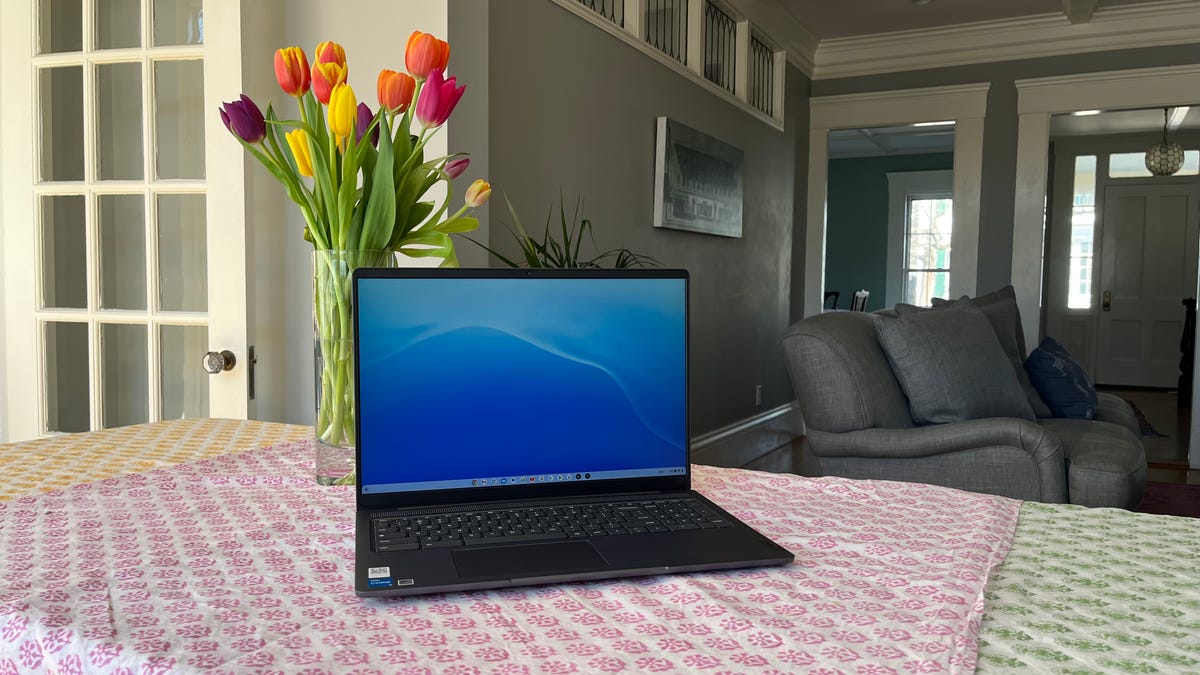
Big-screen Chromebooks began to emerge last year. The 16-inch Acer Chromebook 516 GE was released last fall as one of the first gaming-focused Chromebooks. And before that, the 17.3-inch Acer Chromebook 317 from last spring still holds the crown as the world’s biggest Chromebook. It is certainly large, but the model we tested was based on a low-end Pentium processor and, thus, underpowered — especially when held up against a gaming Chromebook. The Lenovo IdeaPad 5i Chromebook slots in between these two extremes. It boasts a modern, 16-inch, 16:10 display powered by a modern, 12th-generation Core i3 chip but lacks the extra hardware found on a gaming Chromebook.
What prevents the IdeaPad 5i Chromebook from being included among this new breed of gaming Chromebook? For one, its display has the standard 60Hz refresh rate rather than a speedy 120Hz for smoother motion in games. For another, it lacks an anti-ghosting keyboard that can register every keystroke, even during the most furious action in a game. What you are left with, however, is a highly capable, roomy Chromebook for home use, whether you are working from home or just need an extra laptop for browsing the web and watching shows and movies. Just don’t stray too far from a wall outlet.
Like
- Roomy 16-inch 16:10 display
- Strong, Core i3 performance
- Solid build quality
- 1080p webcam
Don’t Like
- Short battery life
- No keyboard backlighting
Our IdeaPad 5i Chromebook test model costs $550 from Lenovo but is currently discounted to $420. It costs £550 in the UK and isn’t available in Australia, but the UK price converts to AU$1,020. That pricing puts it in the midrange of the Chromebook scale, and it offers excellent value with a 12th-gen Core i3 CPU, 8GB of RAM and 128GB of local storage. The roomy, 16-inch display features a crisp, 1,920×1,200-pixel resolution with 16:10 aspect ratio and is rated for a sufficient 300 nits of brightness. And above the display resides a sharp 1080p webcam with a physical privacy shutter.
The Core i3-1215U might be a bit underpowered in a workhorse Windows laptop and have you pining for a more powerful Core i7 or even a midrange Core i5 chip. But in this Chromebook, the i3 has plenty of muscle to run Google’s lightweight ChromeOS without a hitch. Apps open quickly, and I was able to multitask with more than a dozen tabs running in Chrome without experiencing any lag.
Its 3D graphics performance is lackluster as indicated by its poor 3DMark result, but it performed well on Google’s Octane 2 benchmark, which measures its ability to run a variety of web applications. It managed to last only 5 hours and 21 minutes on our online streaming battery drain test, however, which is a great deal shorter than competing Chromebooks and a bit shocking given that the system is based on an efficient U-series Intel Core processor.
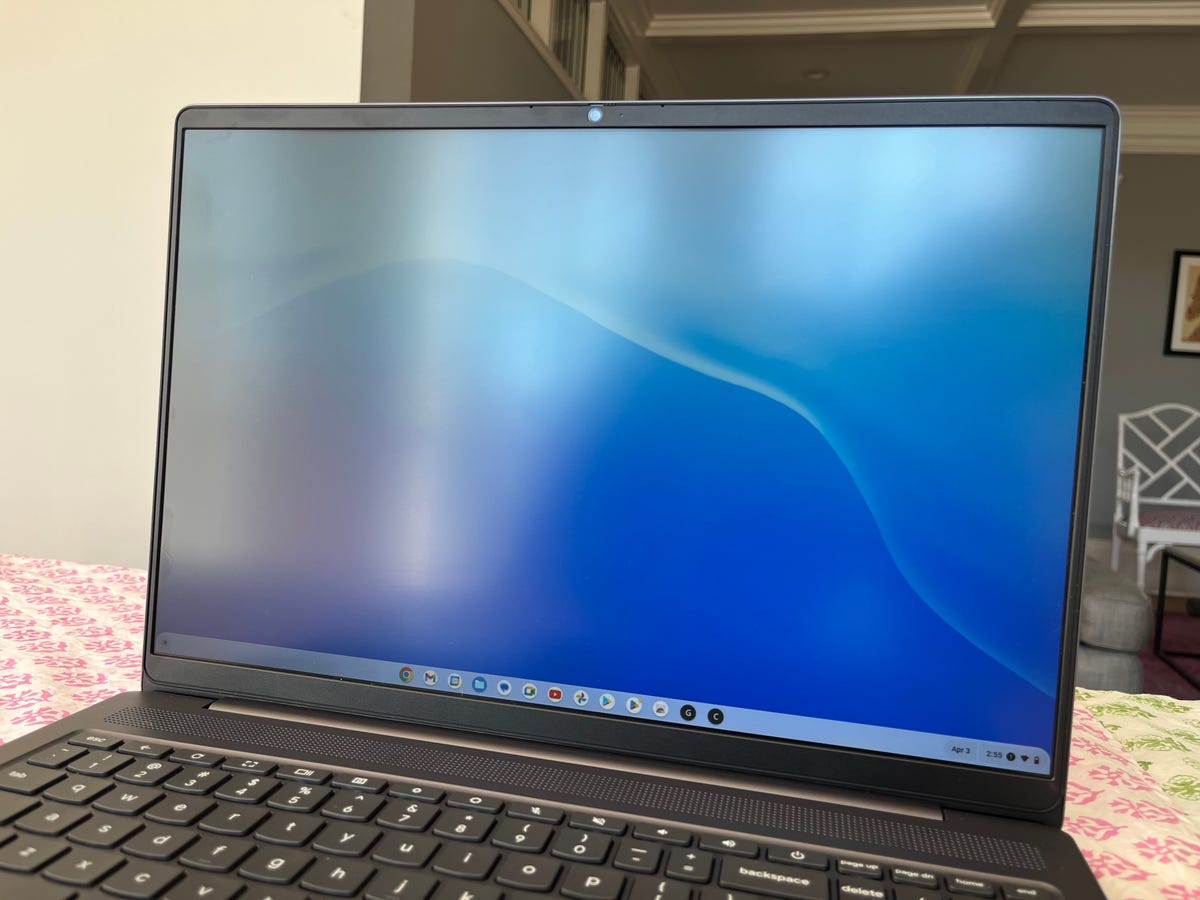

Capacious Chromebook
Despite its large, 16-inch, 16:10 display, the IdeaPad 5i Chromebook remains quite portable, weighing a reasonable 4.2 pounds. That’s nearly a pound lighter than the 5-pound, 17.3-inch Acer Chromebook 317 but slightly heavier than the 3.8-pound, 16-inch Acer Chromebook 516 GE. It might be a bit too big to carry to class each day, and the below-average battery life also keeps it from being a top pick for campus life.
Like most mainstream Chromebooks, the IdeaPad 5i features a plastic enclosure. But this one looks and feels better than the typical plastic Chromebook. The dark gray color gives it an understated, classy look. Even better is the firm feel of the plastic chassis; there is very little flex in the keyboard deck and lid protecting the display.
The display features a fine, 1,920×1,080-pixel resolution with a 16:10 aspect ratio that’s taller than a traditional 16:9 widescreen display. The added vertical space means you need to scroll less through long documents and web pages. The display really feels roomy and provides ample space for multitaskers to juggle open windows. The display is rated for a sufficient 300 nits of brightness, and my own measurements confirmed that rating. The display looked washed out under direct sunlight but provided enough brightness in every indoor scenario, including a sun-drenched breakfast nook.
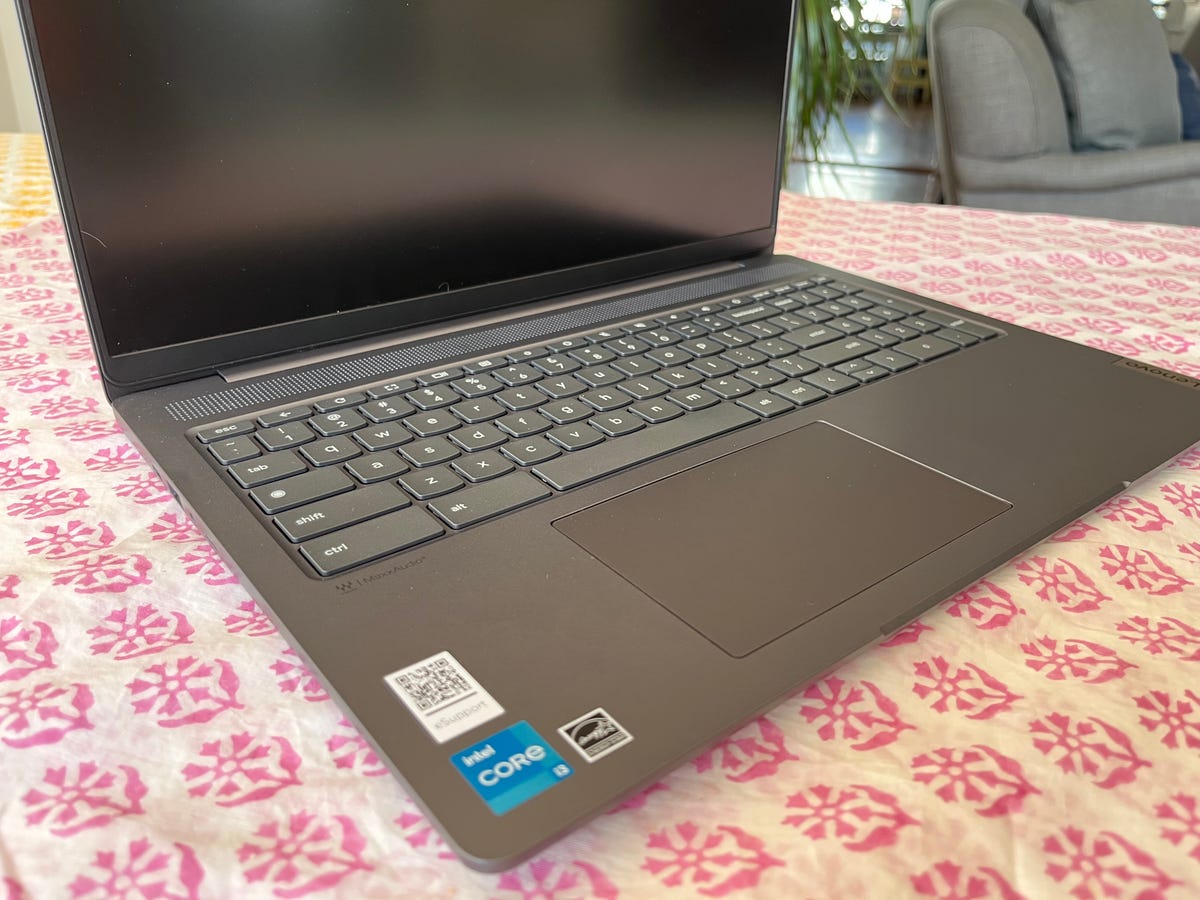

The display features a standard 60Hz refresh rate, but that doesn’t mean you can’t play games on it. Browser-based games ran smoothly in Chrome and looked great on the big display. The speakers produce underwhelming, muddied audio, so keep your headphones or Bluetooth speaker nearby for playing games and watching shows and movies.
Along with the modern display and modern CPU comes a modern webcam in the form of a 1080p camera. It produces a clean, well-balanced image that’s night and day compared to the image you’re likely accustomed to from a 720p webcam. The webcam also has a physical privacy shutter, which lends peace of mind when the camera isn’t in use.
Asus squeezes in a number pad that Excel jockeys and other data-entry types might enjoy, but its inclusion doesn’t ruin the rest of the keyboard. The keys feel well-spaced and offer a soft and quiet but responsive feel. The keyboard lacks backlighting, making typing more difficult than need be in a dark room. We see some budget models with a lack of keyboard backlighting but expect to see this useful feature on a mainstream model.
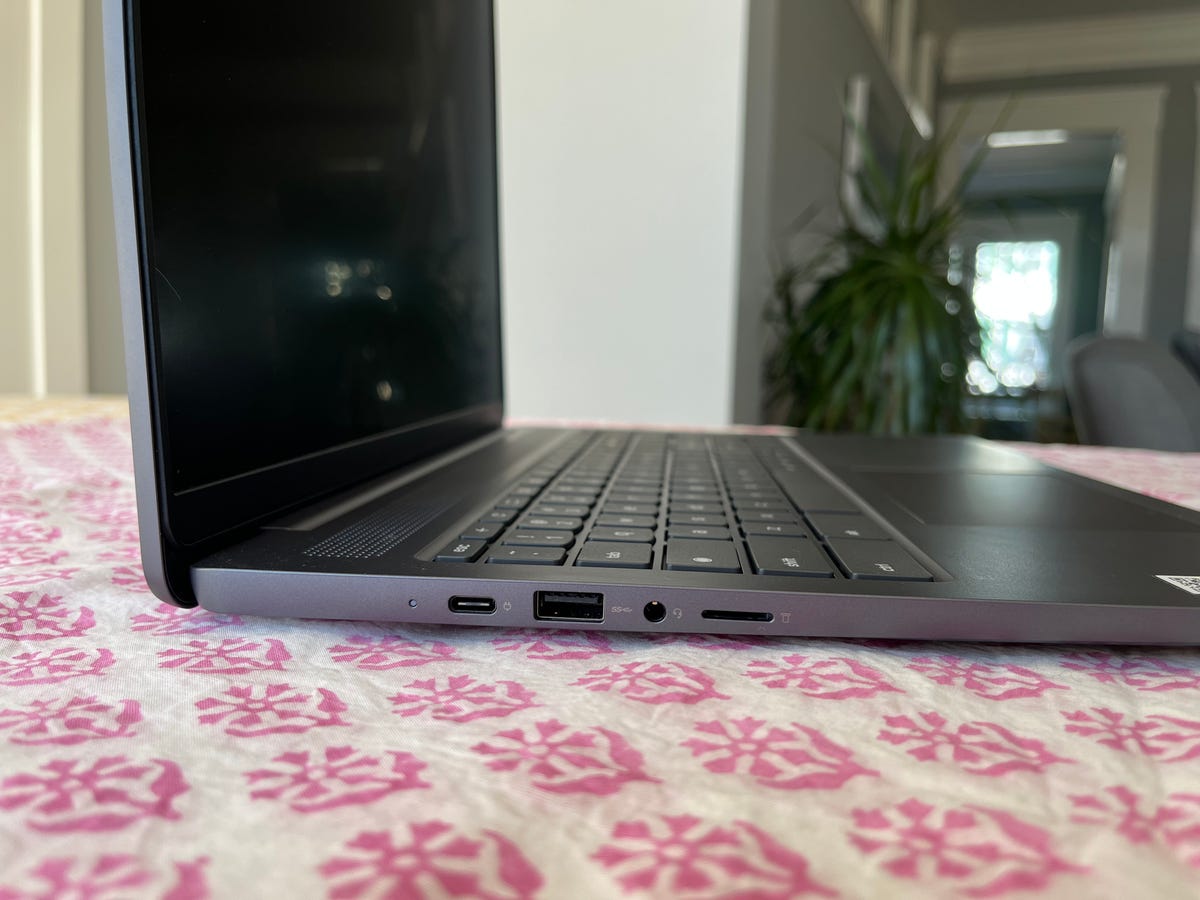

The IdeaPad 5i Chromebook lacks an HDMI port, but it does supply a pair of USB-C ports for your external monitor, data and power connection needs. There are also two USB-A ports for connecting a mouse or older USB devices, and you also get a microSD card slot for easy local storage expansion if you fill up the 128GB eMMC flash storage.
With its roomy display, a powerful-for-a-Chromebook Core i3 processor and an attractive, well-built chassis, the Lenovo IdeaPad 5i Chromebook is a great pick as a WFH Chromebook or an extra family entertainment device for your home. It’s inexpensive and provides snappy performance and ample screen space for multitaskers to get you through the busiest parts of the day and watching shows and movies at night. And the full-HD webcam will allow you to appear crisp and clear to your video conference mates, too. For students trekking to class each day, however, a smaller and more portable Chromebook with longer battery life such as the Acer Chromebook Spin 513 or Lenovo Flex 5i Chromebook is a better choice.
3DMark Wild Life Unlimited
Note:
Longer bars indicate better performance
Google Octane 2
Note:
Longer bars indicate better performance
Online streaming battery drain test
Note:
Longer bars indicate better performance
System Configurations
| Lenovo IdeaPad 5i Chromebook | Google Chrome OS 110.0.5481.181/Android 11; 1.2GHz Intel Core i3-1215U; 8GB RAM; 128GB SSD |
|---|---|
| Acer Chromebook 714 | Google Chrome OS 103.0.5060.132/Android 11; 2.5GHz Intel Core i5-1235U; 8GB RAM; 256GB SSD |
| Acer Chromebook 514 | Google Chrome OS 99.0.4844.57/Android 9; 2.6GHz MediaTek Kompanio 828 Octa-Core MT8192T ARM Cortex-A76/A55 Multi-Processor; 8GB RAM; 64GB SSD |
| Asus Chromebook Vibe CX55 Flip | Google Chrome OS 110.0.54470/Android 11;2.4GHz Intel Core i5-1135G7;8GB RAM; 256GB SSD |
| Acer Chromebook 516 GE | GoogleChrome OS 110.0.54470/Android 11; 1.7GHz Intel Core i5-1240P; 8GB RAM; 256GB SSD |
Technologies
Today’s NYT Connections Hints, Answers and Help for Dec. 24, #927
Here are some hints and the answers for the NYT Connections puzzle for Dec. 24 #927

Looking for the most recent Connections answers? Click here for today’s Connections hints, as well as our daily answers and hints for The New York Times Mini Crossword, Wordle, Connections: Sports Edition and Strands puzzles.
Today’s NYT Connections puzzle is kind of tough. Ooh, that purple category! Once again, you’ll need to look inside words for hidden words. Read on for clues and today’s Connections answers.
The Times has a Connections Bot, like the one for Wordle. Go there after you play to receive a numeric score and to have the program analyze your answers. Players who are registered with the Times Games section can now nerd out by following their progress, including the number of puzzles completed, win rate, number of times they nabbed a perfect score and their win streak.
Read more: Hints, Tips and Strategies to Help You Win at NYT Connections Every Time
Hints for today’s Connections groups
Here are four hints for the groupings in today’s Connections puzzle, ranked from the easiest yellow group to the tough (and sometimes bizarre) purple group.
Yellow group hint: Cash out.
Green group hint: Chomp
Blue group hint: Walleye and salmon.
Purple group hint: Make a musical sound, with a twist.
Answers for today’s Connections groups
Yellow group: Slang for money.
Green group: Masticate.
Blue group: Fish.
Purple group: Ways to vocalize musically plus a letter.
Read more: Wordle Cheat Sheet: Here Are the Most Popular Letters Used in English Words
What are today’s Connections answers?
The yellow words in today’s Connections
The theme is slang for money. The four answers are bacon, bread, cheese and paper.
The green words in today’s Connections
The theme is masticate. The four answers are bite, champ, chew and munch.
The blue words in today’s Connections
The theme is fish. The four answers are char, pollock, sole and tang.
The purple words in today’s Connections
The theme is ways to vocalize musically plus a letter. The four answers are hump (hum), rapt (rap), singe (sing) and whistler (whistle).
Don’t miss any of our unbiased tech content and lab-based reviews. Add CNET as a preferred Google source.
Toughest Connections puzzles
We’ve made a note of some of the toughest Connections puzzles so far. Maybe they’ll help you see patterns in future puzzles.
#5: Included «things you can set,» such as mood, record, table and volleyball.
#4: Included «one in a dozen,» such as egg, juror, month and rose.
#3: Included «streets on screen,» such as Elm, Fear, Jump and Sesame.
#2: Included «power ___» such as nap, plant, Ranger and trip.
#1: Included «things that can run,» such as candidate, faucet, mascara and nose.
Technologies
Today’s NYT Mini Crossword Answers for Wednesday, Dec. 24
Here are the answers for The New York Times Mini Crossword for Dec. 24.

Looking for the most recent Mini Crossword answer? Click here for today’s Mini Crossword hints, as well as our daily answers and hints for The New York Times Wordle, Strands, Connections and Connections: Sports Edition puzzles.
Need some help with today’s Mini Crossword? I’m Irish-American, but yet 6-Down, which involves Ireland, stumped me at first. Read on for all the answers.. And if you could use some hints and guidance for daily solving, check out our Mini Crossword tips.
If you’re looking for today’s Wordle, Connections, Connections: Sports Edition and Strands answers, you can visit CNET’s NYT puzzle hints page.
Read more: Tips and Tricks for Solving The New York Times Mini Crossword
Let’s get to those Mini Crossword clues and answers.
Mini across clues and answers
1A clue: Wordle or Boggle
Answer: GAME
5A clue: Big Newton
Answer: ISAAC
7A clue: Specialized vocabulary
Answer: LINGO
8A clue: «See you in a bit!»
Answer: LATER
9A clue: Tone of many internet comments
Answer: SNARK
Mini down clues and answers
1D clue: Sharks use them to breathe
Answer: GILLS
2D clue: From Singapore or South Korea, say
Answer: ASIAN
3D clue: Large ocean ray
Answer: MANTA
4D clue: ___ beaver
Answer: EAGER
6D clue: Second-largest city in the Republic of Ireland, after Dublin
Answer: CORK
Don’t miss any of our unbiased tech content and lab-based reviews. Add CNET as a preferred Google source.
Technologies
Quadrantids Is a Short but Sweet Meteor Shower Just After New Year’s. How to See It
This meteor shower has one of the most active peaks, but it doesn’t last for very long.

The Quadrantids has the potential to be one of the most active meteor showers of the year, and skygazers won’t have long to wait to see it. The annual shower is predicted to reach maximum intensity on Jan. 3. And with a display that can rival Perseids, Quadrantids could be worth braving the cold to see it.
Don’t miss any of our unbiased tech content and lab-based reviews. Add CNET as a preferred Google source.
The show officially begins on Dec. 28 and lasts until Jan. 12, according to the American Meteor Society. Quadrantids is scheduled to peak on Jan. 2-3, when it may produce upwards of 125 meteors per hour. This matches Perseids and other larger meteor showers on a per-hour rate, but Quadrantids also has one of the shortest peaks at just 6 hours, so it rarely produces as many meteors overall as the other big ones.
The meteor shower comes to Earth courtesy of the 2003 EH1 asteroid, which is notable because most meteor showers are fed from comets, not asteroids. Per NASA, 2003 EH1 is a near-Earth asteroid that orbits the sun once every five and a half years. Science posits that 2003 EH1 was a comet in a past life, but too many trips around the sun stripped it of its ice, leaving only its rocky core. The Earth runs through EH1’s orbital debris every January, which results in the Quadrantids meteor shower.
How and where to see Quadrantids
Quadrantids is named for the constellation where its meteors appear to originate, a point known as the radiant. This presents another oddity, as the shower originates from the constellation Quadrans Muralis. This constellation ceased to be recognized as an official constellation in the 1920s and isn’t available on most publicly accessible sky maps.
For the modern skygazer, you’ll instead need to find the Bootes and Draco constellations, both of which contain stars that were once a part of the Quadrans Muralis. Draco will be easier to find after sunset on the evening of Jan. 2, and will be just above the horizon in the northern sky. Bootes orbits around Draco, but will remain under the horizon until just after 1 a.m. local time in the northeastern sky. From that point forward, both will sit in the northeastern part of the sky until sunrise. You’ll want to point your chair in that direction and stay there to see meteors.
As the American Meteor Society notes, Quadrantids has a short but active peak, lasting around 6 hours. The peak is expected to start around 4 p.m. ET and last well into the evening. NASA predicts the meteor shower to start one day later on Jan. 3-4, so if you don’t see any on the evening of Jan. 2, try again on Jan. 3.
To get the best results, the standard space viewing tips apply. You’ll want to get as far away from the city and suburbs as possible to reduce light pollution. Since it’ll be so cold outside, dress warmly and abstain from alcoholic beverages, as they can affect your body temperature. You won’t need any binoculars or telescopes, and the reduced field of view may actually impact your ability to see meteors.
The bad news is that either way, the Quadrantids meteor shower coincides almost perfectly with January’s Wolf Moon, which also happens to be a supermoon. This will introduce quite a lot of light pollution, which will likely drown out all but the brightest meteors. So, while it may have a peak of over 100 meteors per hour, both NASA and the AMS agree that the more realistic expectation is 10 or so bright meteors per hour.
-

 Technologies3 года ago
Technologies3 года agoTech Companies Need to Be Held Accountable for Security, Experts Say
-

 Technologies3 года ago
Technologies3 года agoBest Handheld Game Console in 2023
-

 Technologies3 года ago
Technologies3 года agoTighten Up Your VR Game With the Best Head Straps for Quest 2
-

 Technologies4 года ago
Technologies4 года agoBlack Friday 2021: The best deals on TVs, headphones, kitchenware, and more
-

 Technologies4 года ago
Technologies4 года agoVerum, Wickr and Threema: next generation secured messengers
-

 Technologies4 года ago
Technologies4 года agoGoogle to require vaccinations as Silicon Valley rethinks return-to-office policies
-

 Technologies4 года ago
Technologies4 года agoOlivia Harlan Dekker for Verum Messenger
-

 Technologies4 года ago
Technologies4 года agoiPhone 13 event: How to watch Apple’s big announcement tomorrow

